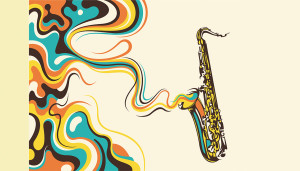The unique and melodious sounds of the saxophone are recognized by almost everyone. If you love the music of the “Big Band” era of the 1930s and 1940s, as exemplified by the sweet sounds of Glenn Miller and other big bands, you’ve heard the unmistakable sounds of the saxophone.
The saxophone is an instrument capable of depicting many moods—like the mournful saxophone solo in Revel’s Bolero and other classical pieces. No instrument comes close to the cool sounds of hot jazz and the precise sounds of a military band—the saxophone is an important and indispensable member of these ensembles and more.
In the 20th Century, the saxophone became a vital part of jazz music. They first appeared in dance bands and were important in the meteoric rise of the big band “Swing Era.” The emergence of the sax as a principal jazz instrument was firmly established by tenor saxophonist, Coleman Hawkins in Fletcher Henderson’s band in 1923.
In the late 1920s, the Duke Ellington orchestra featured an ensemble of saxophones with sax solos. The 1930s saw arrangements of saxophones and brass (trumpets and trombones) playing off each other in call-response patterns. One of the greatest influences for jazz musicians was Charlie Parker, who became an icon of the “Bebop” revolution in the 1940s.
In the 1950s and beyond the saxophone was further popularized by some great jazz musicians: Cannon Ball Adderley; Paul Desmond; Lester Young; Jimmy Dorsey; John Coltrane; Sonny Rollins; Stan Getz; Gerry Mulligan and Kenny G, among others.
Inventor
Antoine-Joseph”Adolphe” Sax, (1814-1894) a Belgian born instrument maker, developed the saxophone, circa 1840. He followed in his father’s footsteps—also an instrument maker of some note. Sax studied the flute and clarinet at the Royal Conservatory of Brussels. He left the conservatory to pursue other interests and to experiment with new instrument designs.
Prior to his work on the saxophone he drew from the knowledge he gained while working on improvements on the bass clarinet and a large conical brass instrument called the ophicleide.
One of the purposes of inventing the saxophone was to make an instrument to bridge the middle ground between the woodwinds and brass. Sax anticipated that these new instruments would be the most powerful of the woodwind family and blend well with both woodwinds and brass.
In 1841, after Sax invented the saxophone, he moved to Paris where he lived and worked for the remainder of his life. He obtained a patent for his instrument designs in 1846. In 1857 Sax was appointed instructor of saxophone at The Paris Conservatory.
His initial idea was that the saxophone would be used in both orchestra and military bands. But saxophones in the orchestra saw little exposure, except for a few compositions by primarily French composers. Hector Berlioz and German composer, Richard Strauss, among others, included saxophone parts in some of their works. However, the use of saxophones in both military and concert bands is another story.
The Saxophone
The Harvard Dictionary of Music defines the saxophone as a family of hybrid instruments, played with a single beating or vibrating reed, like the clarinets, but they are conical in bore, like the oboes. Their key arrangement or fingering, also resembles the oboes but their mouthpiece is like the clarinets.
The body of the instrument is metal, like the brass instruments. The range of the instrument is two and a half octaves. The sound and tonal properties of the saxophone is quite flexible and variable. Its timbre is intermediate, between woodwind and brass. The dynamic range or volume, is also quite wide, and can play like the softness of a flute to the strength and power of a cornet or trumpet.
Sax designed the instrument in seven different sizes. The complete family consists of the Sopranino in Eb; Soprano in Bb; Alto in Eb; Tenor in Bb; Baritone in Eb; Bass in Bb and Contra Bass in Eb. They are all transposing instruments and written in the treble clef.
Usage and Function
The first popular usage of the saxophone was in military bands. The sax was especially prominent in France and Belgian bands. It was not used by the German bands in the beginning but later adopted by them. The British and American bands use them and today are virtually in all military bands.
Concert bands quickly brought them into their instrumentation and today the alto, tenor and baritone sax are in almost all bands. The Bb soprano is occasionally written in some concert band pieces.
It is customary for many saxophonists to also double on clarinet. Many of the “Big Band” era arrangements called for clarinet in the musical scores. In musicals it is a common practice to have saxophone and clarinet parts in the same book.
The saxophone has a long and storied history providing a variety of entertaining music for many musicians and their listeners.
Please submit your questions and comments to banddirector01@comcast.net
Visit our website at www.danvilleband.org for up-to-date information about the Danville Community Band.
Leave a Reply